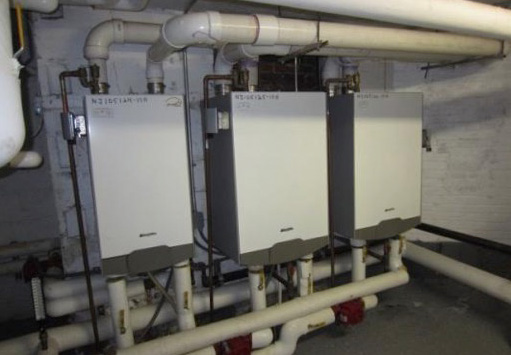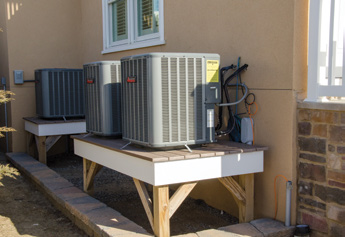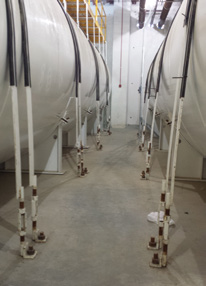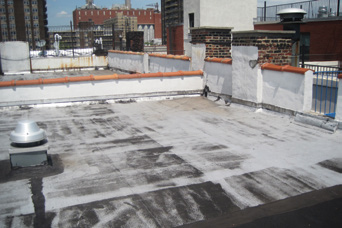Floodproofing.
Description + function
- Boilers and furnaces.
- Water heaters.
- Fuel storage tanks.
- Fire-suppression sprinkler controls.
- Elevator machine rooms.
- Duct work.
- Electrical panels and switch gear.
- Backup generators.
- Alarm controls and components.
- Service wiring and receptacles.
- Energy management systems.
- Telecommunications equipment.
- Electric and gas meters.
- Utility shut-off switches.
Strategy into action
-
Audit the facility’s heating and cooling needs. Consider downsizing equipment, purchasing more efficient equipment or decentralizing the system. Envelope efficiency upgrades can reduce the demand on mechanical systems and allow them to be downsized (See Strategy: Envelope Performance). It may be less expensive to buy equipment than to relocate heavy, inefficient older equipment.


-
Use your elevation certificate to identify the Base Flood Elevation to determine possible relocation (See:Getting Started).
Possible locations include converted areas on floors above the DFE, an exterior courtyard on a raised platform or the roof. - Consult the local utility to discuss relocation options for equipment and service entrances. Consider bringing in an electrical contractor or architect for advice.
- Consult a structural engineer to ensure the upper floors or roof are capable of supporting the relocated equipment. Rooftop equipment must be properly secured against high winds.
- Consider the type of enclosure necessary to ensure water-tightness and wind-resistance if equipment is moved outside or on the roof.
- Code-mandated electrical fixtures and switches below the DFE should be on a separate circuit that can be shut off when the area is flooded, allowing the rest of the electrical system to run normally. Any wiring below the DFE should be rated for wet locations.

Fuel is typically stored in basements. A partly-filled tank exerts tremendous buoyancy and, during a flood, can break free of the floor and float.
Proper anchoring will prevent tanks from moving, lines from rupturing and fuel from leaking into floodwaters, while preventing fires and other environmental hazards. Both permanent and temporary fuel tanks should be strapped and anchored to a concrete slab or mounted on anchored pillars.
Operations + maintenance
When relocating equipment, consider access for servicing, cleaning and inspection.
Relocation also provides an opportunity to clean ducts or heat exchanger coils and carry out general service and efficiency retrofits. Even if a heating plant is being replaced, the distribution system may need cleaning or other improvements. These improvements can be highly cost effective.
Estimated Cost
-
$
-
$$
-
$$$
-
$$$$
Supporting Strategies
Resources
-
Evaluating Water-Damaged Electrical Equipment, National Electrical Manufacturer’s Association, 2011.
www.nema.org/Standards/Pages/Evaluating-Water-Damaged-Electrical-Equipment.asp -
Protecting Building Utilities and Ductwork from Flood Damage.
www.fema.gov/media-library/assets/documents/21322 -
Protecting Building Utilities from Flood Damage: Principles and Practices for the Design and Construction of Flood Resistant Building Utility Systems, FEMA, P-348, November 1999.
www.fema.gov/media-library/assets/documents/3729 -
Quick Reference Guide: Comparison of Select NFIP and Building Code Requirements for Special Flood Hazard Areas, FEMA. March 2012.
www.fema.gov/media-library/assets/documents/25986
Background
Located in the AE Flood Zone, the 22-unit building at 134 Avenue C, New York is operated by the Lower East Side People’s Mutual Housing Association (LESPMHA). During Superstorm Sandy the basement was flooded, damaging the mechanical and electrical systems, boilers and meter rooms.
Strategy
LESPMHA is beginning work on a new rooftop boiler room that will protect the elevated system from the elements. Electrical systems and meters are being installed on the first floor, above the BFE, and emergency systems, HVAC and plumbing are being repaired and upgraded.
Cost
Elevating the boiler will cost $315,000 and the electrical components, $174,000. Funding for the project came from a Community Development Block Grant, Disaster Recovery (CDBG-DR).

